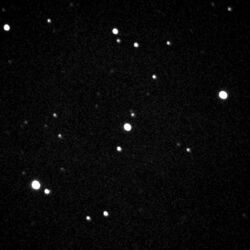Astronomy:WASP-1
From HandWiki
Short description: Star in the constellation Andromeda
| Observation data Equinox J2000.0]] (ICRS) | |
|---|---|
| Constellation | Andromeda[1] |
| Right ascension | 00h 20m 40.077s[2] |
| Declination | +31° 59′ 23.79″[2] |
| Apparent magnitude (V) | 11.68 ± 0.05[3] |
| Characteristics | |
| Spectral type | F7V[4] |
| Apparent magnitude (B) | ~12.0[5] |
| Apparent magnitude (V) | 11.68 ± 0.05[3] |
| Astrometry | |
| Proper motion (μ) | RA: −4.706±0.078[2] mas/yr Dec.: −3.237±0.072[2] mas/yr |
| Parallax (π) | 2.5171 ± 0.0676[2] mas |
| Distance | 1,300 ± 30 ly (400 ± 10 pc) |
| Absolute magnitude (MV) | 3.63+0.13 −0.14[3] |
| Details[3] | |
| Mass | 1.301+0.049 −0.047 M☉ |
| Radius | 1.515+0.052 −0.045 R☉ |
| Luminosity | 2.88+0.36 −0.30 L☉ |
| Surface gravity (log g) | 4.190+0.020 −0.022 cgs |
| Temperature | 6110±75 K |
| Metallicity [Fe/H] | 0.26±0.08 dex |
| Age | 3.0±0.6 Gyr |
| Other designations | |
| Database references | |
| SIMBAD | data |
WASP-1 is a metal-rich magnitude 12 star located about 1,300 light-years away in the Andromeda constellation.[6]
Planetary system
In 2006, an extrasolar planet was discovered by the Wide Angle Search for Planets team using the transit method.[4] The planet has a density of 0.31 to 0.40 g/cm3, making it about half as dense as Saturn, and one third as dense as water. The orbit of WASP-1b is inclined to rotational axis of the star by 79.0+4.3−4.5 degrees, making it a nearly "polar" orbit.[7]
Two searches for additional planets using transit-timing variations have yielded negative results.[8][9]
| Companion (in order from star) |
Mass | Semimajor axis (AU) |
Orbital period (days) |
Eccentricity | Inclination | Radius |
|---|---|---|---|---|---|---|
| b | 0.948+0.029 −0.028 MJ |
0.03958+0.00047 −0.00049 |
2.51994480±0.00000050 | <0.013 | 90.0+0.0 −2.9° |
1.514+0.052 −0.047 RJ |
See also
- SuperWASP
- List of extrasolar planets
References
- ↑ Roman, Nancy G. (1987). "Identification of a Constellation From a Position". Publications of the Astronomical Society of the Pacific 99 (617): 695–699. doi:10.1086/132034. Bibcode: 1987PASP...99..695R. Vizier query form
- ↑ 2.0 2.1 2.2 2.3 2.4 Brown, A. G. A. (August 2018). "Gaia Data Release 2: Summary of the contents and survey properties". Astronomy & Astrophysics 616: A1. doi:10.1051/0004-6361/201833051. Bibcode: 2018A&A...616A...1G. Gaia DR2 record for this source at VizieR.
- ↑ 3.0 3.1 3.2 3.3 Torres, Guillermo; Winn, Joshua N.; Holman, Matthew J. (2008). "Improved Parameters for Extrasolar Transiting Planets". The Astrophysical Journal 677 (2): 1324–1342. doi:10.1086/529429. Bibcode: 2008ApJ...677.1324T.
- ↑ 4.0 4.1 Cameron, A. Collier et al. (2007). "WASP-1b and WASP-2b: two new transiting exoplanets detected with SuperWASP and SOPHIE". Monthly Notices of the Royal Astronomical Society 375 (3): 951–957. doi:10.1111/j.1365-2966.2006.11350.x. Bibcode: 2007MNRAS.375..951C. https://academic.oup.com/mnras/article/375/3/951/1139249.
- ↑ 5.0 5.1 "TYC 2265-107-1". SIMBAD. Centre de données astronomiques de Strasbourg. http://simbad.u-strasbg.fr/simbad/sim-basic?Ident=TYC+2265-107-1.
- ↑ Stempels, H. C. et al. (2007). "WASP-1: a lithium- and metal-rich star with an oversized planet". Monthly Notices of the Royal Astronomical Society 379 (2): 773–778. doi:10.1111/j.1365-2966.2007.11976.x. Bibcode: 2007MNRAS.379..773S. https://academic.oup.com/mnras/article/379/2/773/1026310.
- ↑ Simpson, E. K.; Pollacco, D.; Cameron, A. Collier; Hébrard, G.; Anderson, D. R.; Barros, S. C. C.; Boisse, I.; Bouchy, F. et al. (2011). "The spin-orbit angles of the transiting exoplanets WASP-1b, WASP-24b, WASP-38b and HAT-P-8b from Rossiter-Mc Laughlin observations★". Monthly Notices of the Royal Astronomical Society 414 (4): 3023–3035. doi:10.1111/j.1365-2966.2011.18603.x. Bibcode: 2011MNRAS.414.3023S.
- ↑ Granata, V. et al. (2014). "TASTE IV: Refining ephemeris and orbital parameters for HAT-P-20b and WASP-1b". Astronomische Nachrichten 335 (8): 797–803. doi:10.1002/asna.201412072. Bibcode: 2014AN....335..797G.
- ↑ Maciejewski, G. et al. (2014). "Revisiting Parameters for the WASP-1 Planetary System". Acta Astronomica 64 (1): 11–26. Bibcode: 2014AcA....64...27M. http://acta.astrouw.edu.pl/Vol64/n1/pdf/pap_64_1_3.pdf.
- ↑ Bonomo, A. S. et al. (2017). "The GAPS Programme with HARPS-N at TNG . XIV. Investigating giant planet migration history via improved eccentricity and mass determination for 231 transiting planets". Astronomy and Astrophysics 602: A107. doi:10.1051/0004-6361/201629882. Bibcode: 2017A&A...602A.107B. https://www.aanda.org/articles/aa/full_html/2017/06/aa29882-16/aa29882-16.html.
External links
- "Planet WASP-1 b". Extrasolar Planets Encyclopaedia. https://exoplanet.eu/catalog/wasp_1_b--346/. Retrieved 2018-11-07.
- Image WASP 1
Coordinates: ![]() 00h 20m 40s, +31° 59′ 24″
00h 20m 40s, +31° 59′ 24″
 |

